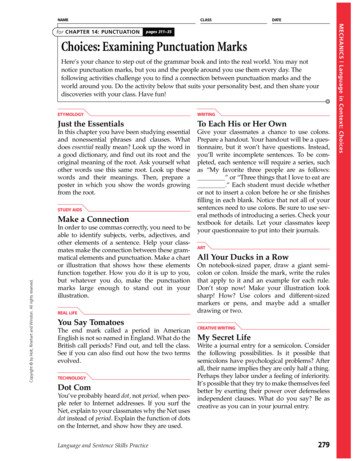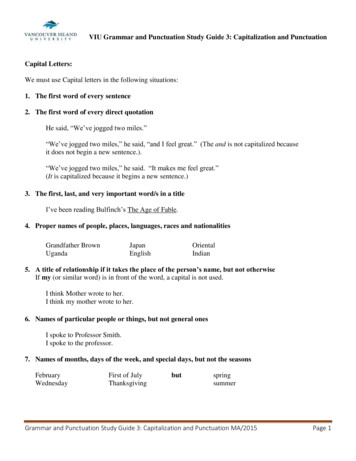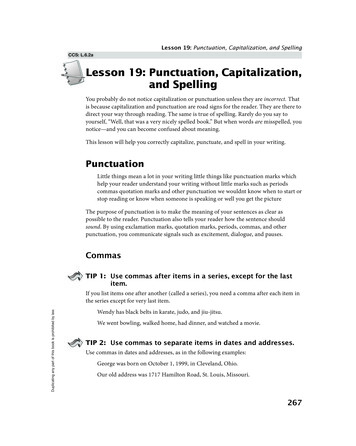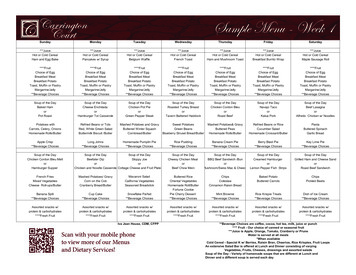
Transcription
NAMEDATEpages 311 35Choices: Examining Punctuation MarksHere’s your chance to step out of the grammar book and into the real world. You may notnotice punctuation marks, but you and the people around you use them every day. Thefollowing activities challenge you to find a connection between punctuation marks and theworld around you. Do the activity below that suits your personality best, and then share yourdiscoveries with your class. Have fun!ETYMOLOGYWRITINGJust the EssentialsTo Each His or Her OwnIn this chapter you have been studying essentialand nonessential phrases and clauses. Whatdoes essential really mean? Look up the word ina good dictionary, and find out its root and theoriginal meaning of the root. Ask yourself whatother words use this same root. Look up thesewords and their meanings. Then, prepare aposter in which you show the words growingfrom the root.Give your classmates a chance to use colons.Prepare a handout. Your handout will be a questionnaire, but it won’t have questions. Instead,you’ll write incomplete sentences. To be completed, each sentence will require a series, suchas “My favorite three people are as follows:” or “Three things that I love to eat are.” Each student must decide whetheror not to insert a colon before he or she finishesfilling in each blank. Notice that not all of yoursentences need to use colons. Be sure to use several methods of introducing a series. Check yourtextbook for details. Let your classmates keepyour questionnaire to put into their journals.STUDY AIDSCopyright by Holt, Rinehart and Winston. All rights reserved.Make a ConnectionIn order to use commas correctly, you need to beable to identify subjects, verbs, adjectives, andother elements of a sentence. Help your classmates make the connection between these grammatical elements and punctuation. Make a chartor illustration that shows how these elementsfunction together. How you do it is up to you,but whatever you do, make the punctuationmarks large enough to stand out in yourillustration.REAL LIFEYou Say TomatoesThe end mark called a period in AmericanEnglish is not so named in England. What do theBritish call periods? Find out, and tell the class.See if you can also find out how the two termsevolved.TECHNOLOGYDot ComYou’ve probably heard dot, not period, when people refer to Internet addresses. If you surf theNet, explain to your classmates why the Net usesdot instead of period. Explain the function of dotson the Internet, and show how they are used.Language and Sentence Skills PracticeARTAll Your Ducks in a RowOn notebook-sized paper, draw a giant semicolon or colon. Inside the mark, write the rulesthat apply to it and an example for each rule.Don’t stop now! Make your illustration looksharp! How? Use colors and different-sizedmarkers or pens, and maybe add a smallerdrawing or two.CREATIVE WRITINGMy Secret LifeWrite a journal entry for a semicolon. Considerthe following possibilities. Is it possible thatsemicolons have psychological problems? Afterall, their name implies they are only half a thing.Perhaps they labor under a feeling of inferiority.It’s possible that they try to make themselves feelbetter by exerting their power over defenselessindependent clauses. What do you say? Be ascreative as you can in your journal entry.279MECHANICS Language in Context: Choicesfor CHAPTER 14: PUNCTUATIONCLASS
NAMECLASSfor CHAPTER 14: PUNCTUATIONDATEpages 311 12End MarksAn end mark is a mark of punctuation placed at the end of a sentence.14a. Use a period at the end of a statement (or declarative sentence).EXAMPLE The manatee is also called a sea cow.14b. Use a question mark at the end of a question (an interrogative sentence).EXAMPLE Have you ever seen a manatee?EXAMPLE That’s amazing!14d. Use a period or an exclamation point at the end of a request or a command (an imperativesentence).EXAMPLES Please read this book about manatees. [a request]Give me that book right now! [a command]EXERCISE In the following sentences, add periods, question marks, and exclamation points where theyare needed.!Example 1. Look at this amazing photograph1. Do you know where Sanibel Island is2. Sometimes you can see manatees off the coast3. Did you know they are endangered4. Please give me that book about endangered speciesCopyright by Holt, Rinehart and Winston. All rights reserved.MECHANICS14c. Use an exclamation point at the end of an exclamation (an exclamatory sentence).5. What wonderful photos it contains6. I’d like to learn more about endangered species7. Will you teach me what you’ve learned8. What an exciting book this is9. I have learned a lot about animals from this book10. Can you recommend some other good books280HOLT HANDBOOKSecond Course
NAMECLASSfor CHAPTER 14: PUNCTUATIONDATEpages 313 14Abbreviations14e. Many abbreviations are followed by a period.EXAMPLES Joel H. FairweatherCo.Inc.M. E. rk.Rd.An acronym is a word formed from the first (or first few) letters of a series of words.EXAMPLES MADDZIPOPECCADDOSRAMAbbreviations for units of measure are usually written without periods. However, you shoulduse a period with the abbreviation in. (for inch or inches) to distinguish it from the word in.EXAMPLES kmmlfttspEXERCISE A Insert periods where appropriate in the following sentences.Example 1. I read a biography of C S Lewis.1. Mrs Walsh is the principal of Westdale Elementary School.2. Have you met Dr Richards?3. Zechariah Hoyt, Jr, wrote the prize-winning essay on ocelots.4. Mr and Mrs Bertinot are joining us for dinner tonight.Copyright by Holt, Rinehart and Winston. All rights reserved.5. Mr A D Mannion will be playing drums with the band tonight.EXERCISE B On the line provided, write the abbreviation or acronym for the word or phrase.FBIExample1. Federal Bureau of Investigation6. ounce7. pound8. yard9. National Aeronautics and Space Administration10. Public Broadcasting Service11. teaspoon12. centimeter13. Central Intelligence Agency14. Individual Retirement Account15. feetLanguage and Sentence Skills Practice281MECHANICSAbbreviations for government agencies and some widely used abbreviations are writtenas acronyms.EXAMPLES FBICDNFLABC
NAMECLASSfor CHAPTER 14: PUNCTUATIONDATEpages 311 14End Marks and Abbreviations14a. Use a period at the end of a statement (or declarative sentence).14b. Use a question mark at the end of a question (an interrogative sentence).14c. Use an exclamation point at the end of an exclamation (an exclamatory sentence).14d. Use a period or an exclamation point at the end of a request or a command (an imperativesentence).Will you be going?Hurry!Come with me.14e. Many abbreviations are followed by a period.EXAMPLES J. R. EwingHUDRev.CIANebr.lbP.M.St.Ltd.EXERCISE A In each of the following sentences, add periods, question marks, and exclamation pointswhere needed.?Example 1. Did you see Mrs Hanson in the hallway1. What a wonderful day this is2. Watch out for that hole, Mr Willis3. The meeting is at 2:00 this afternoon4. Is Dr Winston in today5. James Koenecke, Sr, is speaking to our class6. Have you read anything by F Scott Fitzgerald7. How magnificent the dove’s wings are8. Did Mrs Evans once work for the FBI9. The plane is about to take off, so hurry up10. Our class did research on the life of John F Kennedy, JrEXERCISE B Add periods, question marks, and exclamation points where they are needed in the following sentences.?Example 1. Did you speak with Walter Griffey, Jr11. Will Mr and Mrs Walton be coming to the play12. Watch out for that car13. Are we going to hear Ms Sills sing again14. They were advised to speak with a specialist in internal medicine15. What lovely roses Mrs Greene grows282HOLT HANDBOOKSecond CourseCopyright by Holt, Rinehart and Winston. All rights reserved.MECHANICSEXAMPLES I’d like to go.
NAMECLASSfor CHAPTER 14: PUNCTUATIONDATEpages 315 18Commas with Items in a Series14f. Use commas to separate items in a series.EXAMPLES His pocket was full of pennies, nickels, and dimes. [nouns]14g. Use commas to separate two or more adjectives preceding a noun.EXAMPLE This adorable, cuddly puppy is available for adoption.EXERCISE A In the following sentences, insert commas where they are needed.,Example 1. Tony worked at a mint so that he could learn how money is made where it is,stored and how the new counterfeit-proofing measures work.1. He examined studied and took notes on the history of paper money.2. On U.S. bills are portraits of Washington Lincoln and Hamilton.3. I read a well-written interesting article about the designs on the corners of bills.4. At the mint, Tony watched the complicated intricate processes of taking bills off the assemblyCopyright by Holt, Rinehart and Winston. All rights reserved.line and packing the money.5. He doesn’t know who determines when money is too old to use where it goes or how itis replaced.EXERCISE B In the following paragraph, insert commas where they are needed.,,Example [1] My French teacher got to hear speak and learn some French this summer.[6] Mr. Carrillo took an interesting adventurous trip to Europe. [7] He flew to France traveledoverland to Spain and took a boat to England. [8] He traveled in the air by land and on the water.[9] Visiting cathedrals eating pastries and seeing palaces were his favorite activities. [10] The tripwas educational enjoyable and memorable.Language and Sentence Skills Practice283MECHANICSThe coins were small, shiny, and numerous. [adjectives]Counting, rolling, and depositing the coins took all day. [gerunds]Daphne knew where the bank was, how late it was open, and how we could get there.[subordinate clauses]I counted the money, Daphne put it in the envelope, and we left. [short independentclauses]
NAMECLASSfor CHAPTER 14: PUNCTUATIONDATEpages 319 20Commas with Compound Sentences14h. Use a comma before a coordinating conjunction (and, but, for, nor, or, so, or yet) when it joinsindependent clauses in a compound sentence.EXAMPLES The children must go to bed early, or they will be tired in the morning.The sky was dark and cloudy, but the sun was still out.EXERCISE A In the following sentences, insert commas where they are needed.,Example 1. I’m interested in sound so I recently read several books about it.1. The books were informative but I learned even more in my science class.2. Big speakers called woofers make low sounds and small speakers called tweeters makehigh sounds.3. Sound comes from something moving yet you can’t always see the movement.4. Air carries vibrations to your ears and then you hear sounds.5. Most hearing-impaired people can hear some sounds and they can feel the vibrations.EXERCISE B In the following sentences, insert commas where they are needed.,Example 1. I thought I left my jacket on the porch but it’s not there.6. I wrote a short book about butterflies and Joshua drew the illustrations.7. If possible, Salim will meet Beula on Tuesday or he will meet her on Friday.8. Field hockey is an exciting team sport but soccer is my all-time favorite sport.9. I couldn’t make it to the scout meeting so I called the troop leader to tell him.10. I submitted my best paintings and drawings to the annual art contest but another student inmy class won first prize.284HOLT HANDBOOKSecond CourseCopyright by Holt, Rinehart and Winston. All rights reserved.MECHANICSWhen the independent clauses are very short, the comma before and, but, or or is sometimesomitted.EXAMPLE I’m ready but Paul isn’t.
NAMECLASSfor CHAPTER 14: PUNCTUATIONDATEpages 321 23Commas with Interrupters A14i. Use commas to set off an expression that interrupts a sentence.(1) Use commas to set off nonessential participial phrases and nonessential subordinate clauses.Do not set off essential (or restrictive) phrases or clauses.EXAMPLES My aunt, having been in school for five years, is now an architect. [nonessentialphrase]Those years that she spent in school have prepared her well. [essential clause]MECHANICS(2) Use commas to set off nonessential appositives and nonessential appositive phrases.EXAMPLES My best friend, Ramona Suarez, came here from Mexico. [nonessential]My brother Samuel is the oldest of my brothers. [essential]EXERCISE In the sentences below, identify each underlined phrase or clause by writing above it E foressential or NE for nonessential. Insert commas where they are needed.NEExample 1. Our nation made up mostly of immigrants and their descendants is one of the,,largest in the world.1. The United States’ unique mix of ideas and cultures which come from all over the world hashelped to make this nation diverse and interesting.2. The contributions made by immigrants have included inventions and business ideas.3. One group that has contributed a great deal is Hispanic Americans.Copyright by Holt, Rinehart and Winston. All rights reserved.4. Hispanic Americans many of whom are bilingual have roots in various countries.5. This group one of the fastest-growing minorities has enriched this nation.6. Many Mexican Americans answering the United States’ call for migrant workers arrivedseveral decades ago.7. These workers who were paid poorly strengthened the U.S. economy.8. Unions that they later formed helped them earn better wages.9. Studying diversity which one can find in abundance in the United States is helpful inunderstanding sociological trends within a country.10. Many Americans who are bilingual are able to get better-paying jobs than those who speakonly one language.Language and Sentence Skills Practice285
NAMECLASSfor CHAPTER 14: PUNCTUATIONDATEpages 324 25Commas with Interrupters B14i. Use commas to set off an expression that interrupts a sentence.(3) Use commas to set off words of direct address.EXAMPLES When did you get here, Aiyana?That notebook, Jeff, is mine.(4) Use commas to set off parenthetical expressions.EXERCISE Add commas where necessary in the following sentences.,,Example 1. This tree in my opinion is the most beautiful in the yard.1. Dr. Phillips should I make an appointment with you next week?2. The race therefore was equally challenging to all the contestants.3. Are you going to join us for tea Mrs. Collins?4. The rowers of course were exhausted after the three-hour race.5. Small dogs for example can be great pets for the elderly.6. The students generally speaking enjoy a great deal of variety in the lesson plans.7. Have you read this article yet Janet?8. Mrs. Wyatt is this painting yours?Copyright by Holt, Rinehart and Winston. All rights reserved.MECHANICSA parenthetical expression is a remark that adds information or shows a relationshipbetween ideas.EXAMPLES That vase, I believe, dates from the twelfth century.On the other hand, it may not be as old as I think.9. Those antiques by the way are mostly forgeries.10. The mayor on the other hand disagreed with the committee’s decision.286HOLT HANDBOOKSecond Course
NAMECLASSfor CHAPTER 14: PUNCTUATIONDATEpages 326 27Commas with Introductory Elements14j. Use a comma after certain introductory elements.(1) Use a comma to set off a mild exclamation such as well, oh, or why at the beginning of a sentence.Other introductory words, such as yes and no, are also set off with commas.EXAMPLES Oh, I see.Yes, she has that book.MECHANICS(2) Use a comma after an introductory phrase or clause.EXAMPLES At the bend in the road, turn right. [two prepositional phrases]Signaling carefully, she changed lanes. [participial phrase]To water the garden, use the sprinkler. [infinitive phrase]When the artists painted, they followed several rules. [adverb clause]EXERCISE A In the following sentences, insert commas where they are needed. If a sentence is alreadycorrect, write C to the left of the item number.,Example 1. On the shores of the Nile a great civilization was born.1. No the Egyptians were not just farmers.2. Concerned with the afterlife Egyptian rulers built great tombs for themselves.3. Built for monarchs and nobles many great stone tombs contained supplies for use in the afterlife.4. While he was alive the king had his picture painted.5. On the wall of his tomb a picture shows the king hunting.6. Well it shows how the king once hunted.Copyright by Holt, Rinehart and Winston. All rights reserved.7. When I saw the jewels I thought the kings were rich.8. Why they believed they could take jewels to the next life.9. Based on things found in tombs the assumption can be made that they believed they could takealmost everything!10. In Egypt great riches have been found in these tombs.EXERCISE B In the following paragraph, insert commas where they are needed.Example,[1] During the years of the Middle Ages beekeeping was an important part ofvillage life.[11] Known as the beeward the village beekeeper kept the hives. [12] Before sugar was readilyavailable the only sweetener people had was honey. [13] By supplying beeswax the beewards alsomet another key need of that time—they provided a raw material for making wax candles.[14] For most people in those days cheaper candles were made from tallow. [15] Extracted fromanimal fat tallow was also used to make soap.Language and Sentence Skills Practice287
NAMECLASSfor CHAPTER 14: PUNCTUATIONDATEpages 315 27Using Commas14f. Use commas to separate items in a series.14g. Use commas to separate two or more adjectives preceding a noun.14h. Use a comma before a coordinating conjunction (and, but, for, nor, or, so, or yet) when it joinsindependent clauses in a compound sentence.14i. Use commas to set off an expression that interrupts a sentence.EXERCISE Insert commas where they are needed in the following sentences.,,Example 1. Mrs. Rogers by the way will be the substitute teacher next week.1. We brought sandwiches fruit and drinks to the picnic.2. The cold humid weather took everyone by surprise.3. I studied all week for the test yet I didn’t feel prepared.4. Oh I should mention that we finished the project last night.5. The jurors on the other hand did not understand the testimony.6. The coach made a list of drills posted them on the bulletin board and asked her team membersto practice the drills daily.7. John joined the baseball team Marta joined the soccer team and Juanita joined the basketballteam.Copyright by Holt, Rinehart and Winston. All rights reserved.MECHANICS14j. Use a comma after certain introductory elements.8. It was a long slow climb to the top of the mountain but we made it.9. Keeping an eye out for danger the squirrel nibbled on sunflower seeds.10. My best friend who is from Tacoma is the first violinist in our band.288HOLT HANDBOOKSecond Course
NAMEfor CHAPTER 14: PUNCTUATIONCLASSDATEpage 328Conventional Uses of Commas14k. Use commas in certain conventional situations.(1) Use commas to separate items in dates and addresses.EXAMPLES On December 17, 1903, in Kitty Hawk, North Carolina, modern aviation was born.The aviator’s address is 12 Sky Lane, Rocketville, IN 46208.(2) Use a comma after the salutation of a personal letter and after the closing of any letter.EXAMPLES Dear Andrés,Yours truly,MECHANICSEXERCISE The following letter is missing commas. Insert commas where they are needed.,,Example The next class field trip will take place on Tuesday March 20 2001.18 Varnum StreetCharlottesville VA 22901January 29 2001Dear AngelaI was delighted to read your last letter, and I’m happy to know that you are doing well.Things are going well here in good old Charlottesville Virginia and I miss you.Last month on Friday December 16, our class went to the National Air and Space Museum inWashington D.C. On the way we stopped in Manassas Virginia for a snack and a stretch break.Copyright by Holt, Rinehart and Winston. All rights reserved.At the museum, we saw an exhibit on the history of flight, and I learned about the first memberof the Caterpillar Club, Harold Harris. He bailed out of a plane at McCook Field Dayton Ohio andbecame the first member of a club that is made up of people saved by a parachute! The exhibitwas all so interesting.I remember you asked me for Mrs. DeLillo’s address. She is at Sunnybrook Nursing HomeGreystone Road Blacksburg VA 24060. She went there sometime in November 2000. I guess youknow that she is scheduled for surgery on Tuesday February 7. I know she would be happy tohear from you. You could tell her about your vacation in Paris France. Her birthday is February23 1933. Did you know that she was born in Biloxi Mississippi? I hope to hear from you soon.Your friendYokoLanguage and Sentence Skills Practice289
NAMECLASSfor CHAPTER 14: PUNCTUATIONDATEpages 315 28Comma Review A14f. Use commas to separate items in a series.14g. Use commas to separate two or more adjectives preceding a noun.14h. Use a comma before a coordinating conjunction (and, but, for, nor, or, so, or yet) when it joins independent clauses in a compound sentence.14i. Use commas to set off an expression that interrupts a sentence.14k. Use commas in certain conventional situations.EXERCISE Insert commas where they are needed in the following sentences.,,,Example 1. The younger more delicate kittens on the other hand will be adopted out tofamilies who already have at least one cat.1. The costly fragile items will be moved first.2. In a box under the coffee table you will find the books that you requested.3. Well I’m not sure I would go on that trip if I were you.4. The audience members by the way have never seen a musical production like this one.5. Dr. Gravatz are you ready for your next patient?6. The singers learned the music memorized the words and rehearsed the songs daily.7. We asked how to solve the problem how to indicate the answer and where to print the results.Copyright by Holt, Rinehart and Winston. All rights reserved.MECHANICS14j. Use a comma after certain introductory elements.8. Joanna Killeen was born on November 10 1961.9. Jeffrey Hellmer a world-class pianist studied in Rochester New York.10. Barney doesn’t play trombone nor does he play trumpet.290HOLT HANDBOOKSecond Course
NAMECLASSfor CHAPTER 14: PUNCTUATIONDATEpages 315 28Comma Review B14f. Use commas to separate items in a series.14g. Use commas to separate two or more adjectives preceding a noun.14h. Use a comma before a coordinating conjunction (and, but, for, nor, or, so, or yet) when it joinsindependent clauses in a compound sentence.14i. Use commas to set off an expression that interrupts a sentence.MECHANICS14j. Use a comma after certain introductory elements.14k. Use commas in certain conventional situations.EXERCISE Insert commas where they are needed in the following sentences.,,,Example 1. We know jays for example visit our feeder but we can’t identify the other birds.1. The amusement park had roller coasters carousels and pony rides.2. I’m not sure if I would like this music so I will make a decision later.3. I went to see the opera Madama Butterfly but I didn’t understand everything.4. The book you’re reading by the way is by my favorite author.5. Craig moved to 3145 Palmer Avenue Knoxville Tennessee.6. Marcos did you hear my question?7. Having stayed up most of the night the boys were very tired in the morning.Copyright by Holt, Rinehart and Winston. All rights reserved.8. We planted the seeds watered them daily and watched them grow.9. Kenneth Rutter who is my first cousin teaches horseback riding.10. Katerina on the other hand is a skilled graceful skater.11. We will be in Lima Ohio for one day and then we go on to New York.12. Is it true Vinnie that you’ve already finished your research paper?13. I looked all over the living room dining room and kitchen for the cat’s toy.14. I’m leaving so why don’t you leave with me?15. Jason don’t forget to reserve the room.16. Trisha and Karen are in the same classes for English Spanish and math.17. It was a slim green leather volume.18. Dear Kathryn19. While you clear the table I’ll start washing the dishes.20. I’ll always remember June 10 2000 as the day we moved into our new house.Language and Sentence Skills Practice291
NAMECLASSfor CHAPTER 14: PUNCTUATIONDATEpages 331 33Semicolons A14l. Use a semicolon between independent clauses in a sentence when they are not joined by and,but, for, nor, or, so, or yet.EXAMPLE Cotton is grown in the South; it is cultivated for its fibers.14m. Use a semicolon between independent clauses that are joined by a conjunctive adverb or a transitional expression.EXAMPLE Cotton did not do well when planted in the same fields each year; consequently, crop14n. A semicolon (rather than a comma) may be needed to separate independent clauses joined by acoordinating conjunction when the clauses contain commas.EXAMPLE Cotton is a low, bushy plant, by the way; and its fibers, which are attached to the seeds,are contained in a boll.EXERCISE In the following sentences, add semicolons where they are needed.;Example 1. In home economics we have been studying fabrics wool is one of my favorites.1. Wool is a great fabric for cold weather it keeps me warm even when it gets wet.2. My wool sweater is soft, warm, and comfortable it was hand-knit in Norway.3. Wool must be cut from the sheep, carded, spun, and dyed nevertheless, the result is worththe effort.4. I like to wear wool for skating, sledding, and hiking however, my sister, who is allergic towool, never wears it at all.5. I also like to wear rayon and other synthetic materials therefore, I buy many different typesof fabrics.6. Nylon is a strong material however, I always seem to get runs in my nylon hose.7. Some people prefer to wear cotton my father thinks it’s the most comfortable material.8. I like denim in fact, several of my jackets are made of denim.9. I have bought wool sweaters for my brother, my mom, and my grandfather and my grandmother, a lady with excellent taste, once sent me a wool vest for my birthday.10. I have learned a lot about fabrics I will be able to make informed decisions about what kindsof material to buy.292HOLT HANDBOOKSecond CourseCopyright by Holt, Rinehart and Winston. All rights reserved.MECHANICSrotation was eventually instituted.
NAMECLASSfor CHAPTER 14: PUNCTUATIONDATEpages 331 33Semicolons B14l. Use a semicolon between independent clauses in a sentence when they are not joined by and,but, for, nor, or, so, or yet.EXAMPLE We left the park at dusk; it was too dark to look for the lost ball.14m. Use a semicolon between independent clauses that are joined by a conjunctive adverb or atransitional expression.EXAMPLE Joe loaded the camera incorrectly; as a result, one roll of film was ruined.coordinating conjunction when the clauses contain commas.EXAMPLE The debate team includes Jorge, Cindy, and Vladimir; and Martin, Cindy’s brother, is analternate.EXERCISE In the following sentences, add semicolons where they are needed.;Example 1. Last night was a big night I got an award for basketball.1. The sports banquet began an hour late the delay was due to the storm.2. Some roads were flooded consequently, people had to detour.3. Sanjay was in charge of the program his expression showed concern.4. Marielle, the coordinator, was eager to begin the speeches, awards presentations, and banquetbut the guest speaker, who was flying in from Chicago, had not arrived.Copyright by Holt, Rinehart and Winston. All rights reserved.5. The guest, our sponsor, and Coach Zeff were late all three were to present awards.6. Umeko’s dad had planned to leave early nevertheless, he agreed to lead a discussion.7. Spring storms can cause a lot of destruction indeed, homes have been washed away.8. Finally, our guest of honor arrived he was soaked but smiling.9. The applause was deafening it sounded like a roar of thunder!10. After the speeches, Ms. Weinberg brought out the awards the coach presented them to all theparticipants in athletic programs.Language and Sentence Skills Practice293MECHANICS14n. A semicolon (rather than a comma) may be needed to separate independent clauses joined by a
NAMECLASSfor CHAPTER 14: PUNCTUATIONDATEpages 334 35Colons14o. Use a colon before a list of items, especially after expressions like as follows or the following.EXAMPLE Please report to me on the following days: Monday,Tuesday, and Friday.14p. Use a colon before a statement that explains or clarifies a preceding statement.EXAMPLE I agree with what Mrs. Chan said:“Tell the truth and you will be happy.”14q. Use a colon before a long, formal statement or quotation.that this pipeline should never be built. Our lives and the lives of our children and of theirchildren for generations to come depend on preserving the supply of clean water.”14r. Use a colon in certain conventional situations.(1) Use a colon between the hour and the minute.EXAMPLES 11:05 A.M.8:30 P.M.(2) Use a colon after the salutation of a business letter.EXAMPLES Dear Ms. Acevedo:To Whom It May Concern:(3) Use a colon between chapter and verse in Biblical references and between titles and subtitles.EXAMPLES John 3:16Psalms 3:5Light: Medicine of the FutureEXERCISE In the following sentences, add colons where they are needed.:Example 1. We are reading The Environment Whose Responsibility?1. Our teacher introduced Mr. Burkhardt “It is my honor and my pleasure to introduce Mr. SteveBurkhardt. He is a close friend, a mentor, and an accomplished scientist. Please welcome him.”2. Mr. Burkhardt told us something important We must save the elephants.3. He also told me the following items are valued by some people elephant meat, elephant tusks,elephant hides, and elephant hair.4. I read this fact The elephant is on the world’s endangered species list.5. Is the elephant mentioned in Genesis 1 24?6. My concerns are as follows The herds are disappearing, illegal killing is continuing, and therural people of Africa still need these elephants to survive.7. I always remember what is written in Leviticus 19 17–18.8. We will listen to a lecture at 8 30 P.M.9. My father always taught me this Respect life in every form.10. We will learn more about elephants in tomorrow’s lecture, which begins at 9
Here's your chance to step out of the grammar book and into the real world. You may not notice punctuation marks, but you and the people around you use them every day.










